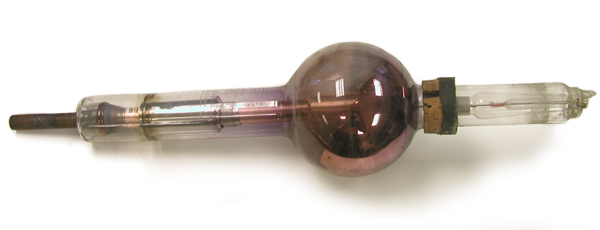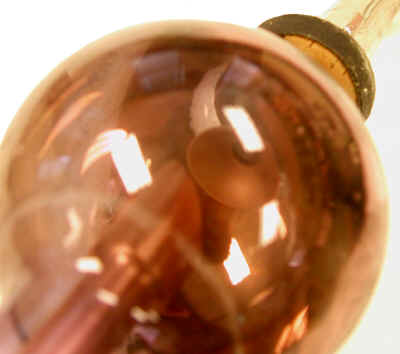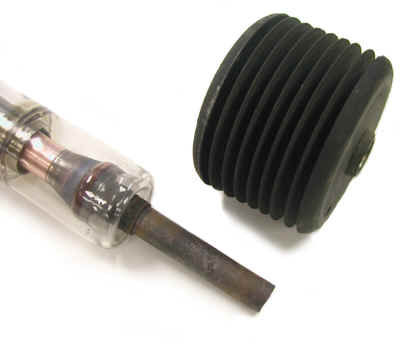General Electric Radiator Tube (ca. 1925-1930)

The etched logo, on the bulb of the tube in the photo above, identifies it as a GE (General Electric) Coolidge tube. The GE subsidiary, Victor X-ray Corporation, would have manufactured the tube in their Chicago facility. In terms of its construction, this GE tube is nearly identical to the collection's Victor radiator tubes.
Unlike the “Universal” X-ray tube, the Radiator was intended for diagnostic work only, not therapy. There was another important difference between the two tubes: the radiator tube was self-rectifying. It could be connected directly to an induction coil or transformer without a separate rectifier (e.g., a valve tube). Inverse currents were not a problem because the heat was removed so efficiently from the target that the latter never got hot enough to emit electrons.
There is no model number indicated on the tube, but I believe it was what General Electric described in Bulletin 293 (1934) as their Model 3R. Although the Bulletin barely mentioned the Model 3R, it did indicate that the 3R was no longer in production, that it employed a round focus, and that it was rated at 30 mA. Consistent with this information, our tube employs a round focus and is rated at 30 mA ("30 MA" is etched on the glass). In the early 1930s, as best as I can determine, the Model 3R was replaced by the model 3RB, a tube that employed the Benson line focus principle.

As seen in the top photo, the anode is the long copper rod that extends horizontally along the glass arm attached to the left side of the spherical glass bulb. If you look closely at the free end of the anode in the center of the bulb, you can make out the copper block that served as a heat sink for the tungsten target. The latter (not visible) is embedded in the sloped face of the copper block. The other end of the copper rod projects several inches out of the left end of the glass arm. Under normal operating conditions, a finned radiator like that seen in the bottom photo would be attached to the exposed end of the rod to help dissipate heat.
Due to overheating of the target, the deposition of copper, and possibly tungsten, on the inside of the tube envelope was so great that the glass on the lower right half of the bulb (as seen in the top photo) has a mirror finish. This excessive deposition indicates that the tube was operated beyond its rated capacity. The glass also has a radiation-induced purple color to it. Unfortunately, this discoloration makes it difficult to see the tubes internal components.

Although the cathode can’t be seen in the top photo, it is located inside the bulb facing the target. The not-so-good photo to the right shows the cathode reasonably well—it consists of a circular (concentric spiral) filament surrounded by a metal focusing cup. For all practical purposes, the filament is identical to that in GE’s “Universal” tube.
Size: ca. 14 1/2" long (excluding rod for radiator fins), 3 3/4" bulb diameter
Donated by the University of Kansas courtesy of Michael Lemon.
